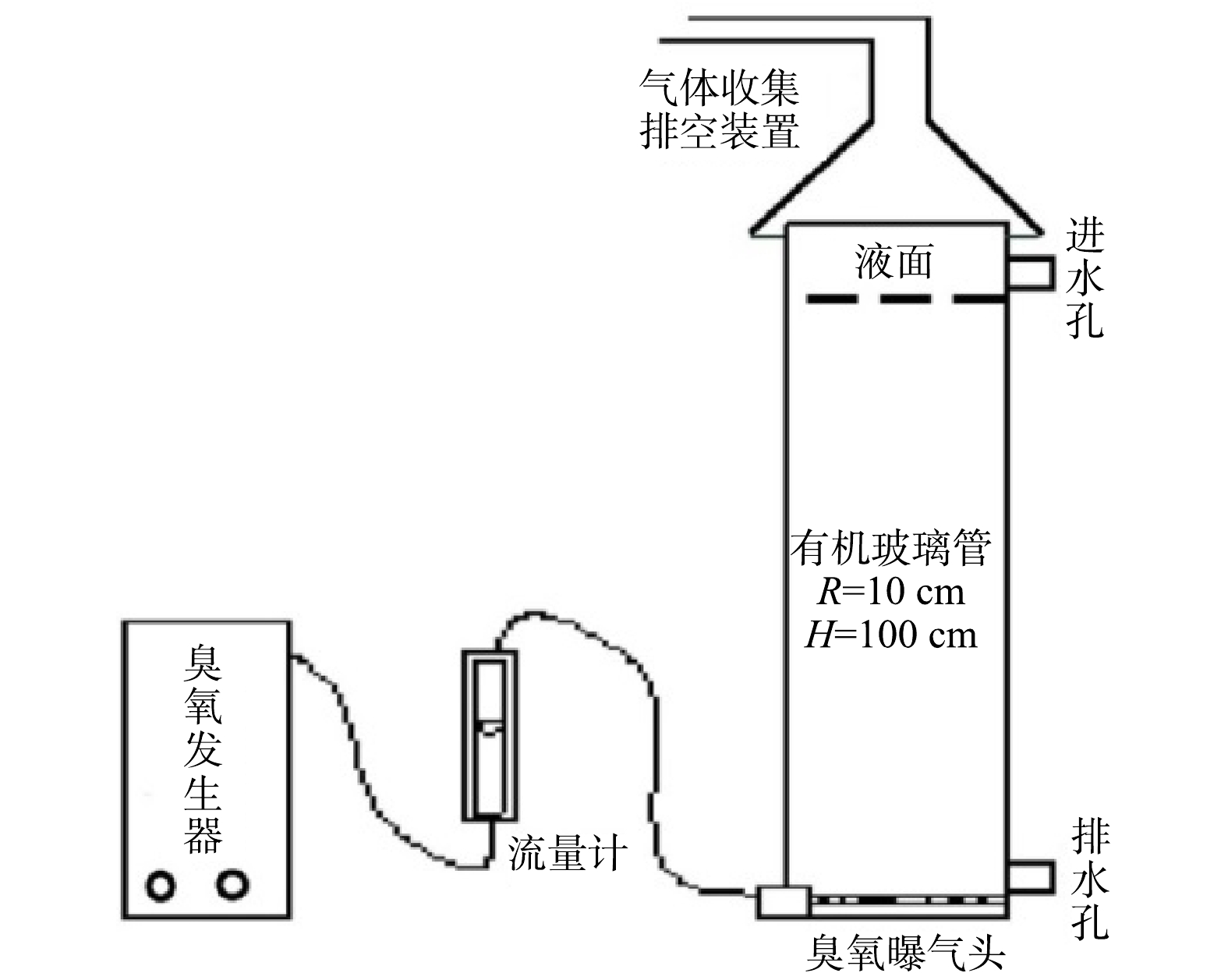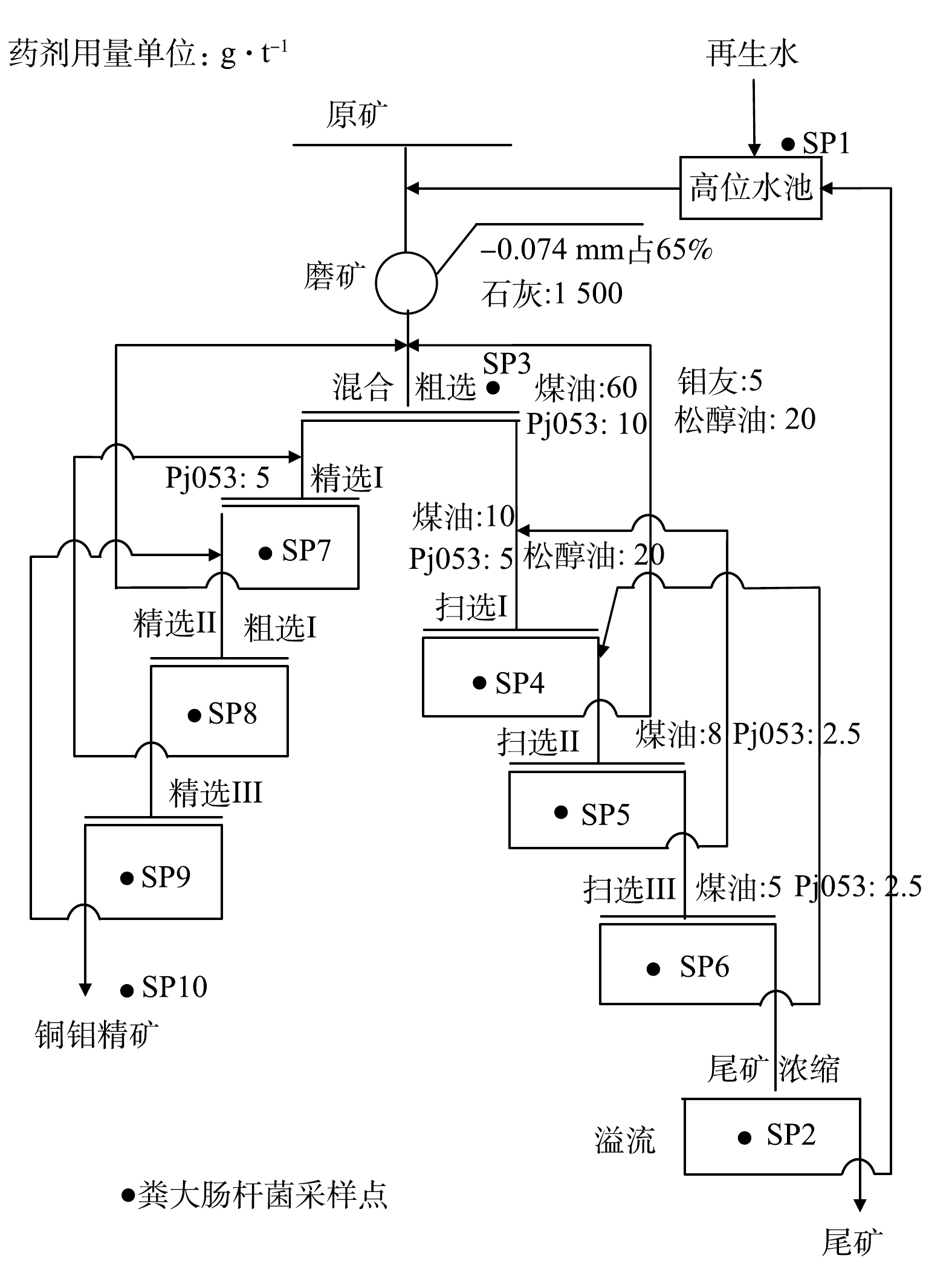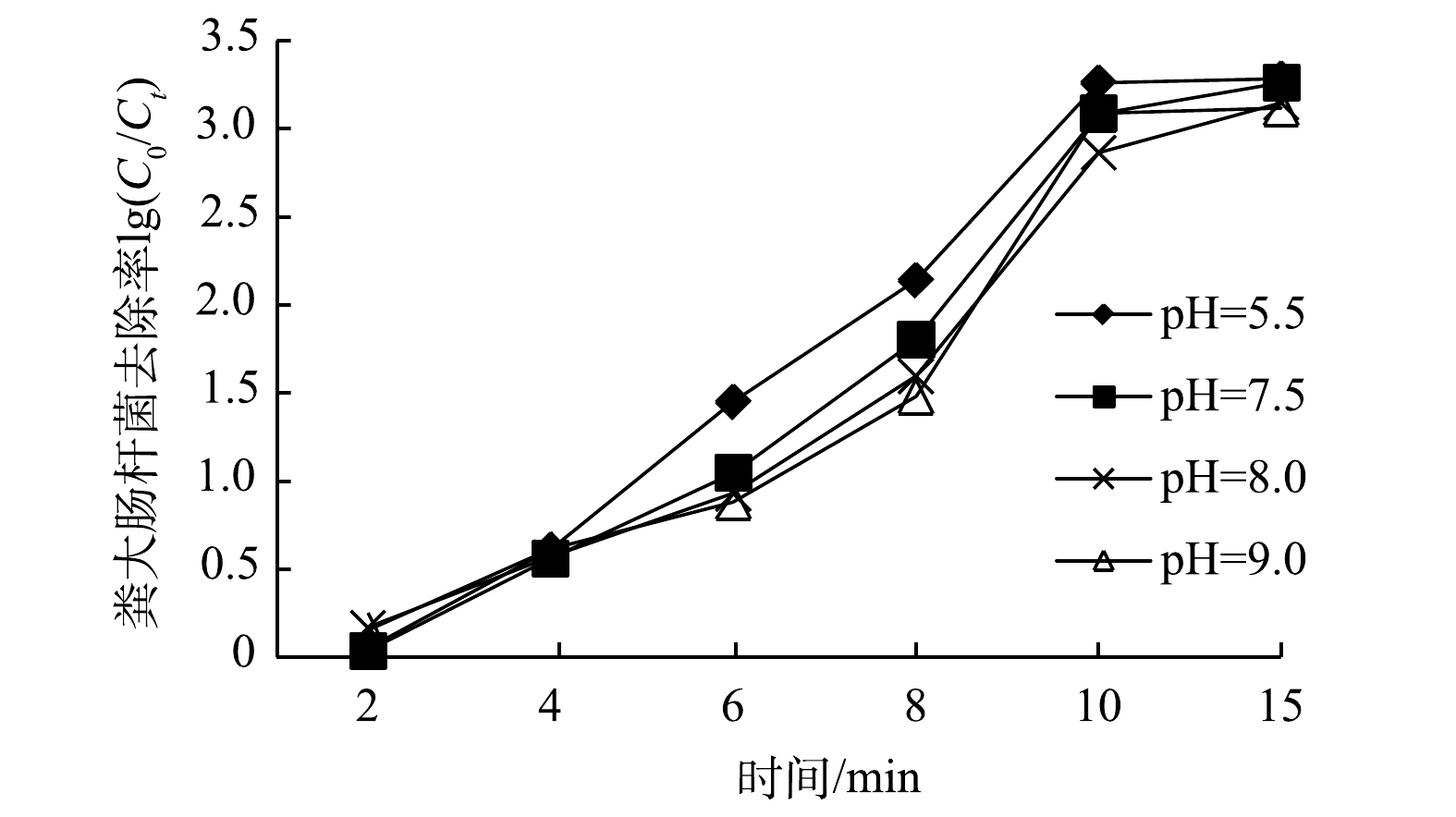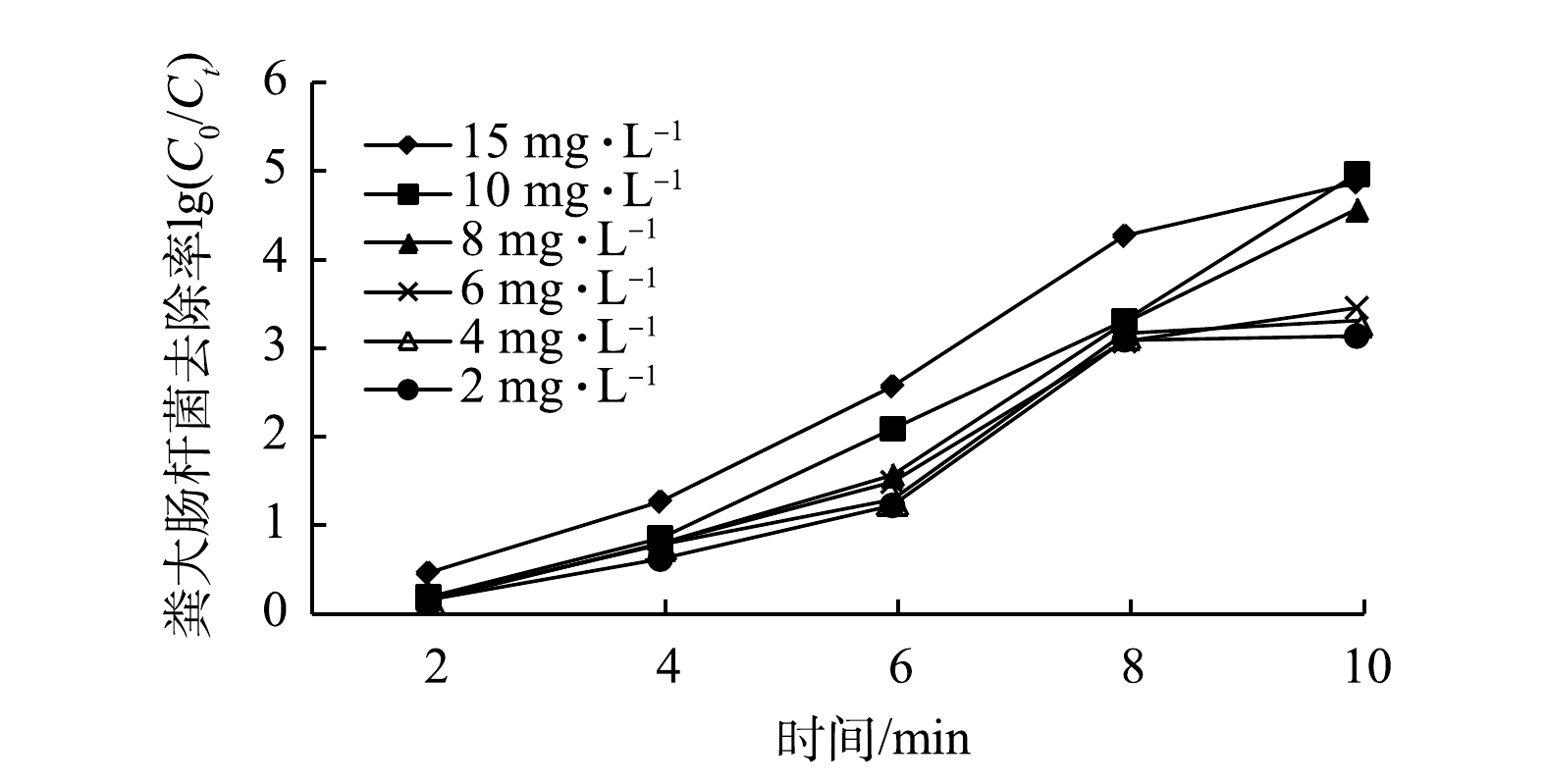-
随着我国碳达峰和碳中和目标的提出,传统工业行业的绿色低碳转型发展势在必行。浮选作为一种常用的选矿方法,耗水量巨大,优化浮选单元的取水结构,加大废水循环利用,不仅可以缓解常规用水的供求矛盾,节约浮选用水成本,还能在一定程度上促进绿色矿山的建设。城镇污水处理厂的二级出水具有水量大、受季节和气候影响小、就地可取的特点,是浮选单元的潜在供水水源。然而,二级出水中的细菌、病毒、原生动物等病原微生物在回用过程中会通过气溶胶传播、皮肤接触等途径对选矿厂工人造成潜在的健康风险[1-3]。有研究表明,城镇污水处理厂的出水回用于景观娱乐性用水时,休闲活动参与者的水源性肠道病原体暴露风险增加,有可能引发急性肠胃疾病、呼吸道疾病、皮肤疾病[4-5];用于喷洒灌溉、洗车、道路清扫时,水中病原体会以气溶胶的形式对人体,产生吸入暴露风险[6-8]。而将二级出水回用于干旱地区的矿区选矿厂浮选用水时,其中的病原微生物的削减和回用后对矿物分离的影响尚无报道。
近年来,臭氧氧化作为一种高效的氧化消毒技术受到了广泛关注[9-11],臭氧自身的氧化作用及其在水中分解产生的羟基自由基不仅可对病原体产生强大的灭活作用、削减病原微生物浓度[12-13]、降低回用水使用风险[14-15],而且可以降解水中有机物。刘洪均等[16]证明了城镇污水处理厂二级出水可以回用于内蒙古某铜钼矿浮选流程。随后,他们进一步发现回用水中的大肠杆菌及病毒等病原微生物在浮选过程存在潜在的健康风险,臭氧氧化作为应急处理措施可以应对该风险,但该研究并未确定臭氧氧化工艺的具体参数及优化后的浮选效果[17-19]。
基于此,本研究采用臭氧氧化技术深度处理城镇污水处理厂二级出水,优化了臭氧氧化操作参数,评价了病原微生物的去除效果,比较了二级出水臭氧处理前后浮选流程中各岗位的健康风险,系统评估了臭氧氧化二级出水回用于浮选单元的适用性。本研究成果可为城镇污水厂二级出水以及矿山生活区污水处理后回用于干旱地区矿区选矿厂提供参考。
-
矿石矿样。实验矿样来自内蒙古某铜钼矿,矿物组成中铜的独立矿物较多如黄铜矿(相对含量0.34%)、蓝辉铜矿(相对含量0.23%)等,脉石矿物以石英、白云母为主。矿样磨矿细度(0.074 mm)约占65%。
实验水样。水样来自内蒙古某市政污水处理厂的出水,该污水处理厂采用曝气活性污泥法二级处理工艺,污水经过过滤、沉淀等物理处理后,进入综合生化池,采用好氧生物处理后进入稳定塘。水样COD为25~60 mg·L−1,pH为6.80~7.60,悬浮物为10~55 mg·L−1,浊度为3.34~16 NTU,氨氮为1.60~5.70 mg·L−1。
-
在实验过程中,分别于不同月份采集二级出水,分析其中的病原微生物含量,明确病原微生物在二级出水中的现有赋存特征。随后,采用实验室的批次实验,取一定量的二级出水投加臭氧进行氧化,改变水样的pH以及臭氧的投加量,以粪大肠杆菌作为指示性微生物,研究臭氧氧化对二级出水中病原微生物的削减效果,优化臭氧氧化的操作参数。实验中采用的臭氧发生装置为奥润牌(S-1BX型)空气源臭氧发生器。如图1所示,臭氧产量为600 mg·h−1,臭氧发生器与曝气头之间连有气体流量计,用于控制臭氧曝气量,反应器为有机玻璃材质,上部设有集气罩及排空装置。
在上述实验的基础上,将市政污水处理厂二级出水通入臭氧氧化处理装置,处理后的水经矿区浮选厂的高位水池进入浮选系统进行铜钼混合浮选闭路实验,主要工艺流程如图2所示。浮选过程中,按照选矿厂原有药剂制度,加入捕收剂(煤油、Pj053、钼友)、酸碱调节剂(石灰)、起泡剂(松醇油),结合选矿厂工艺共设定10个检测点位(图3)。以未经处理的污水处理厂二级出水浮选为对照,分别测定各点位的粪大肠杆菌暴露剂量,评估浮选健康风险。其中高位水池(SP1)采集样品为水样,其余点位采集样品为水和矿物颗粒的混合物。以自来水浮选、未经处理的污水处理厂二级出水浮选为对照,以铜钼混合精矿的产率、品位、回收率为指标,评估浮选效果。
-
1)水质指标的测定。COD 采用快速消解分光光度法(哈希DR1010)测定;氨氮采用水杨酸-靛酚蓝法(哈希Amtax NA8000氨氮检测仪)测定;总磷采用钼酸铵分光光度法 (哈希NPW-160总磷/总氮测定仪)测定;浊度根据光学散射测量原理测定(上海雷磁 WZS-186浊度计);pH采用PHSJ-4F型实验室pH计(上海雷磁)测定。
2)水中细菌的分离与检测。经过滤浓缩后,采用多管发酵法检测粪大肠杆菌,采用平板计数法检测沙门氏菌、金黄色葡萄球菌和粪链球菌[20-21],粪大肠杆菌衰减率根据式(1)计算。
式中:S为粪大肠杆菌衰减率;C0为再生水中粪大肠杆菌初始浓度,个·L−1;Ct为臭氧作用t时刻后粪大肠杆菌浓度,个·L−1;
3)水中病毒的浓缩分离与检测。样品采用膜吸附-洗脱法进行浓缩,用洗脱液以磁力搅拌的方式将病毒洗脱后,利用病毒的保守序列设计通用引物进行PCR扩增,将基因测序结果做BLAST分析,进行分子生物学鉴定。
4)浮选流程中粪大肠杆菌浓度测定。城市生活污水中病原微生物种类繁多,对各工作岗位进行所有病原微生物定量检测并不现实,因此,选用常被用做指示菌种的粪大肠杆菌进行健康风险评估。由于矿物颗粒对粪大肠杆菌的吸附作用,浮选过程中暴露于浮选用水和矿物颗粒都有感染的可能,因此,实验中分别检测浮选用水和矿物颗粒中粪大肠杆菌浓度。为了使矿物颗粒与浮选用水中粪大肠杆菌群浓度计量单位统一,便于对比分析,采用水置换法将矿物颗粒吸附的粪大肠杆菌重新悬浮于PBS缓冲溶液中(0.02 mol·L−1 Na2HPO4,0.1 mol·L−1NaCl,0.003 mol·L−1 KCl pH=7.5),用缓冲溶液提取的粪大肠杆菌浓度来表征矿物颗粒吸附的粪大肠杆菌浓度,浮选用水中粪大肠杆菌采用多管发酵法测定[22]。
5)粪大肠杆菌健康风险定量评估模型。采用β-泊松分布模型计算病原微生物感染概率,病原微生物摄入剂量采用世界卫生组织推荐的意外暴露剂量(1 mL)和蓄意接触剂量(100 mL) [23]。粪大肠杆菌单次暴露感染概率根据式(2)计算,年暴露感染概率根据式(3)计算。
式中:Pi为粪大肠杆菌单次暴露感染概率;N为粪大肠杆菌摄入剂量,个·mL−1;α、β剂量-反应方程参数取值分别为0.1778、1.78×106[24]。
式中:Py为粪大肠杆菌年暴露感染概率;n为暴露频率,次·a−1;根据现场调查,暴露剂量为1 mL的暴露频率为365次·a−1,暴露剂量100 mL的暴露频率为20次·a−1。
-
本研究首先通过对不同月份市政污水处理厂二级出水的采样检测,分析二级出水中病原微生物的原有赋存特征。从表1可以看出,经过好氧生物处理后,污水处理厂二级出水中仍然检测出大量的病原微生物,其中粪大肠杆菌、沙门氏菌和粪链球菌在各个月份均有检出,粪大肠杆菌浓度最高(3.70×105~3.85 ×106 个·mL−1)。从时间分布特征上看,粪大肠杆菌和粪链球菌浓度季节差异明显,7、8月份浓度明显高于其他月份。这与夏季气温偏高有利于细菌繁殖有关。与之相反的是,沙门氏菌浓度(1.10×105~3.20×105 CFU·L−1)在气温较低的月份浓度偏高。这表明高温环境下沙门氏菌活性减弱,而低温环境利于其繁殖。金黄色葡萄球菌(0-320×103 CFU·L−1)偶有检出,检出月份出现在7月和8月。此外,4种细菌的浓度分布未表现出明显相关性。
水中轮状病毒、腺病毒、柯萨奇病毒在不同月份均有检出,检出率分别为77.78%、55.56%、44.44%,轮状病毒检出率最高。3种病毒的检出规律未呈现明显的季节性。上述结果表明,二级出水不经消毒处理直接回用于浮选流程,可能会造成病原微生物在浮选系统内的滋生蓄积,工人因暴露导致的感染风险增加。
-
由表2可以看出,污水处理厂二级出水中病原微生物种类繁多。因此,研究选用《城市污水再生利用 工业用水水质》(GB/T 19923-2005)推荐使用的粪大肠杆菌作为臭氧消毒的指示细菌。污水处理厂出水中粪大肠杆菌浓度波动较大,一般为103~106 个·L−1。基于消毒工艺的安全性考虑,通过接种一定量的粪大肠杆菌菌悬液,使其浓度达到最高值(3.65×106 个·L−1)进行消毒实验。
首先在臭氧投加量为5 mg·L−1的固定条件下,改变二级出水的pH,并考察pH对粪大肠杆菌灭活的影响。由图4可以看出,当pH为5.5~9.0时,消毒效果受pH影响不明显,但是酸性条件下消毒效果略好。这主要是因为酸性环境不利于臭氧的分解,水中作用于粪大肠杆菌的臭氧剂量大,从而灭活效果好。当臭氧氧化时间为0~10 min时,二级出水中粪大肠杆菌被迅速灭活,衰减率高达3.28lg个·L−1。氧化10~15 min后,粪大肠杆菌灭活率趋于稳定;氧化时间为15 min时,粪大肠杆菌几乎彻底灭活。由于污水处理厂二级出水的pH为6.8~7.6,灭活率变化较小,在考虑工艺运行成本的情况下,优先选择不调节pH,消毒时间优选为10 min。
由图5可见,粪大肠杆菌衰减率随着臭氧投加量的增加呈增加趋势。臭氧投加量为2 mg·L−1、消毒时间为10 min时,水中粪大肠杆菌衰减率为3.28lg 个·L−1,此时出水中粪大肠杆菌浓度为2 700 个·L−1,未能达到《城市污水再生利用 工业用水水质》(GB/T 19923-2005)中粪大肠菌群指标要求。当臭氧投加量增加至4 mg·L−1和6 mg·L−1时,再生水中粪大肠杆菌衰减率分别为3.31lg个·L−1和3.44lg 个·L−1,此时出水中粪大肠杆菌浓度分别为1 800 个·L−1和65 个·L−1。当臭氧剂量> 10 mg·L−1时,氧化10 min可使水中粪大肠杆菌被彻底灭活。这主要是由于市政二级出水中尚含有部分有机物,这些有机物也会消耗臭氧,在一定程度上降低消毒效率,随着臭氧投加量的提高,有机物不断被氧化,粪大肠杆菌的灭活效率也得到提高[25-26]。
-
根据图3所示铜钼混合浮选闭路流程进行现场浮选模拟,评估各岗位的健康风险,对比分析混合浮选指标,从安全性和浮选效果综合分析二级出水臭氧氧化后回用于浮选的适用性。
1)二级出水臭氧氧化处理后用于浮选的健康风险分析。臭氧消毒实验表明当臭氧投加量大于4 mg·L−1时,出水水质能达到《城市污水再生利用 工业用水水质》(GB/T 19923-2005)中粪大肠菌群指标要求,但浮选实验流程为闭路实验,浮选用水在循环使用过程中可能会造成粪大肠菌的蓄积,因此基于安全与成本考虑,选用臭氧投加量分别为4 mg·L−1和6 mg·L−1处理的二级出水进行浮选实验,评估各岗位因暴露粪大肠杆菌导致的健康风险,评价阈值采用世界卫生组织推荐的单次感染风险值2.60×10−6、年感染风险值7.30×10−4作为水媒病原微生物感染风险的可接受水平[26]。由于矿物颗粒对粪大肠杆菌的强烈吸附作用,除岗位SP1外,其余岗位浮选用水中均未检测到粪大肠杆菌,感染风险为零。矿物颗粒中粪大肠杆菌感染概率如表2所示。使用臭氧投加量为4 mg·L−1、消毒时间为10 min的二级出水,在暴露剂量为100 mL的条件下,岗位SP1粪大肠杆菌的单次感染概率和年感染概分别为8.09×10−5、1.62×10−3,岗位SP2暴露于矿物颗粒中粪大肠杆菌的单次感染概率为2.24×10−6,均处于不可接受水平。这是因为尾矿浓缩池(SP2)中矿物颗粒富集了大量病原微生物,因而暴露导致的健康风险增大。增加臭氧投加量至6 mg·L−1时,各岗位矿物颗粒中粪大肠杆菌单次感染概率为4.00×10−7~4.79×10−8,年感染概率为1.59×10−6~7.99×10−6,岗位SP1高位水池中粪大肠杆菌的单次感染概率和年感染概率分别为1.35×10−6和4.70×10−4,全部处于可接受水平。当暴露剂量为1 mL时,使用臭氧投加量为4 mg·L−1和6 mg·L−1处理后的水,所有岗位浮选用水和矿物颗粒中粪大肠杆菌感染概率均处于可接受水平。因此,基于二级出水回用过程健康风险考虑,臭氧投加量为6 mg·L−1更为稳妥。
2)二级出水臭氧氧化处理后的浮选实验。选矿厂所在地区属于严寒地区,污水处理厂二级出水水质波动较大,为了考察水质对浮选指标的影响,分别使用混合水(污水处理厂原水与二级出水1:2混合)、二级出水、臭氧氧化处理后的二级出水(臭氧投加量为6 mg·L−1,消毒时间10 min)、进行铜钼混合浮选闭路实验的自来水,浮选结果如表3所示,浮选用水水质数据如表4所示。由表3和表4可见,浮选用水的水质对浮选指标影响较大,随着水中COD、悬浮物浓度的下降,浮选指标逐步得到改善。使用混合水用于浮选,铜钼混合精矿中铜、钼的品位分别为16.54%、0.64%,铜、钼的回收率分别为68.77%、46.87%,浮选过程泡沫层加厚,泡沫发粘,容易出现跑槽现象,而且能明显看到泡沫中夹杂的脉石矿物,此时的产品指标不能满足生产要求。选厂采用的铜钼混合浮选为泡沫浮选,是通过浮选药剂将有用矿物选择性地附着在矿浆中的空气泡上,并随之上浮到矿浆表面,达到有用矿物与脉石的分离的目的,而生活污水中的有机物有可能改变了矿物颗粒疏水性导致泡沫结构改变引起脉石矿物上浮;浮选药剂中的捕收剂煤油、PJ053、钼友为异极性有机化合物,生活污水中有机物可能干扰捕收剂与矿物颗粒的吸附作用,从而导致精矿中铜、钼的品位和回收率下降。另外,水中的悬浮物也会通过物理吸附消耗掉部分浮选药剂导致浮选指标下降;使用二级出水,浮选指标明显好转,铜、钼的品位分别提高了26.90%、78.13%,铜、钼的回收率分别提高了20.02%、62.85%。混合水、二级出水经臭氧氧化处理后用于浮选,浮选指标进一步改善,两者均能满足选厂要求,其中二级出水要优于混合水,其浮选指标与自来水几乎相当。
-
1)二级出水中粪大肠杆菌、沙门氏菌、粪链球菌、轮状病毒检出频率较高,直接使用未经处理的二级出水进行浮选,存在病原微生物感染风险。
2)水质对浮选指标影响较大,水中COD、悬浮物浓度的下降,可以改善浮选指标,增加铜钼精矿中铜、钼的品位和回收率。
3)使用臭氧氧化处理的二级出水进行浮选,当臭氧投加量为6 mg·L−1,消毒时间为10 min时,暴露于浮选用水和矿物颗粒中大肠杆菌的健康风险均处于可接受水平,且浮选指标良好。
臭氧氧化二级出水回用于选矿浮选的适用性
Feasibility of ozonation advanced treatment of secondary effluent for water reuse in flotation unit of mineral processing plants
-
摘要: 为优化干旱矿区浮选单元的取水结构,降低市政污水处理厂二级出水的回用风险,以内蒙古某铜钼矿为代表性研究对象,采用臭氧氧化工艺对该区域市政污水处理厂二级出水进行深度处理,探讨其对水中病原微生物的去除效果,研究处理后的二级出水对浮选指标的影响以及相应的健康风险,评估氧化处理工艺的二级出水回用于选矿浮选单元的适用性。结果表明,二级出水中大肠杆菌浓度具有明显的季节分布性,最高浓度可达3.85 ×106 个·mL−1,轮状病毒检出率为77.78%,直接回用具有一定风险;而且浮选用水的水质对浮选指标影响较大,随着COD、悬浮物浓度的下降,精矿中铜、钼的品位和回收率相应增加,浮选指标得到改善;采用臭氧氧化处理工艺二级出水,在臭氧投加量为6 mg·L−1、氧化时间为10 min、不调节pH的情况下,二级出水中粪大肠杆菌衰减率可达3.44lg 个·L−1。在该工艺条件下,使用处理后的二级出水进行浮选,浮选产品指标合格,且粪大肠杆菌单次暴露感染风险为4.71×10−8~1.35×10−6,年暴露感染风险为1.59×10−6~4.70×10−4,均为可接受水平。Abstract: In order to optimize the water supply structure of flotation unit in mineral processing plant of arid area and decrease the recycle risk of secondary effluent in wastewater treatment plant (WWTP), a copper-molybdenum mine located in Inner Mongolia was taken as the representative case, ozonation oxidation was employed to perform the advanced treatment of secondary effluent from a WWTP in this region. Then the removal efficiency of pathogenic microorganisms in secondary effluent was determined, the influence of treated secondary effluent on the flotation indices and the corresponding health risk were studied, the feasibility of these treated secondary effluent for water reuse in flotation unit of mineral processing plants was also evaluated. The results showed that the Fecal coliform concentration in secondary effluent had an obvious seasonal distribution characteristic with the highest concentration of 3.85×106mL−1, the detection rate of rotavirus was 77.78%, these indicated that direct reuse of secondary effluent had a potential risk. Moreover, the water quality for floatation had a significant effect the flotation indices. With the decrease of COD and suspended solids in water, the grade and recovery of copper and molybdenum in the concentrate increased, and the flotation indices were improved. When ozonation oxidation was used to treat secondary effluent, the attenuation rate of Fecal coliform could reach 3.44log·L−1 at ozone dosage of 6 mg·L−1, oxidation time of 10 min and non-adjusted pH. Under these conditions, the treated secondary effluent could meet the flotation water quality requirements and the qualified flotation products were achieved. Moreover, the single and the annual exposure risk of Fecal coliform were 4.71×10−8~1.35×10−6 and 1.59×10−6~4.70×10−4, respectively, which were both at an acceptable level.
-
Key words:
- arid mining area /
- ozone oxidation /
- flotation /
- pathogen
-

-
表 1 污水处理厂二级出水病原微生物检测结果
Table 1. Detection results of pathogens in secondary water of sewage treatment plant
月份 粪大肠杆菌/
(103个·L−1)沙门氏菌/
(103 CFU·L−1)金黄色葡萄球菌/
(103 CFU·L−1)粪链球菌
/(103 CFU·L−1)腺病毒 轮状
病毒柯萨奇
病毒3月 608 303 0 95 − − + 4月 1 680 320 0 1 360 − + − 5月 362 130 37 213 + + − 6月 1 320 160 0 203 + + + 7月 3 560 200 232 2 560 + + − 8月 3 850 150 102 2 850 + + + 9月 370 110 0 106 + + − 10月 950 260 0 1 800 − + + 11月 680 280 0 950 − − − 注:“+”为阳性,“−”为阴性。 表 2 浮选用水和矿物颗粒中粪大肠杆菌暴露感染概率
Table 2. Probability of Fecal escherichia coli exposure in flotation water and mineral particles
暴露途径 岗位 单次暴露风险 年暴露风险 4 mg·L−1臭氧 6 mg·L−1臭氧 4 mg·L−1臭氧 6 mg·L−1臭氧 浮选用水 SP1 8.09×10−5 1.35×10−6 1.62×10−3 4.70×10−4 矿物颗粒 SP2 2.24×10−6 4.00×10−7 4.47×10−5 7.99×10−6 SP3 1.42×10−6 1.60×10−7 2.84×10−5 3.21×10−6 SP4 4.08×10−7 1.23×10−7 8.15×10−6 2.42×10−6 SP5 4.79×10−7 7.99×10−8 9.59×10−6 1.59×10−6 SP6 4.00×10−7 1.79×10−7 7.99×10−6 3.52×10−6 SP7 4.79×10−7 8.79×10−8 9.60×10−6 1.76×10−6 SP8 2.40×10−7 9.59×10−8 4.79×10−6 1.92×10−6 SP9 1.60×10−7 4.79×10−8 3.20×10−6 7.99×10−6 SP10 4.02×10−7 6.39×10−8 7.89×10−6 1.8×10−6 表 3 再生水铜钼混合浮选闭路实验结果
Table 3. Results of copper-Molybdenum mixed flotation using reclaimed water
水质种类 品位/% 回收率/% 铜 钼 铜 钼 混合水 16.54 0.64 68.77 46.87 臭氧氧化后的混合水 19.35 1.05 81.54 75.36 二级出水 20.99 1.14 82.54 76.33 臭氧氧化后的二级出水 24.86 1.68 86.28 79.55 自来水 25.91 1.80 90.60 88.40 表 4 浮选用水水质
Table 4. water quality in flotation process
水质种类 COD/(mg·L−1) 悬浮物/(mg·L−1) 浊度/(NTU) 氨氮/(mg·L−1) 总磷/(mg·L−1) pH 混合水 170.87 155.67 20.55 67.42 6.65 7.8 臭氧氧化后的混合水 71.42 50.78 5.34 15.44 2.30 7.2 二级出水 65.50 56.34 3.42 5.65 1.60 7.5 臭氧氧化后的二级出水 22.70 50.55 1.85 1.81 1.35 7.6 自来水 2.34 5.62 1.65 0.52 0.10 7.2 -
[1] WÉRY N, LHOUTELLIER C, DUCRAY F, et al. Behaviour of pathogenic and indicator bacteria during urban wastewater treatment and sludge composting, as revealed by quantitative PCR[J]. Water Research, 2008, 42(1-2): 53-57. [2] 张振兴, 王江权, 郑祥. 水体病原微生物定量风险评价: 历史、现状与发展趋势[J]. 环境科学学报, 2016, 36(1): 1-6. [3] ESFAHANI A R, BATELAAN O, HUTSON J L. Combined physical, chemical and biological clogging of managed aquifer recharge and the effect of biofilm on virus transport behavior: A column study[J]. Journal of Water Process Engineering, 2019, 33 (10): 1-11. [4] BEAUDEQUIN D, HARDEN F, ROIKO A , et al Modelling microbial health risk of wastewater reuse: Asystems perspective [J]. Environment International , 2015, 84 (8) : 131-141 [5] 孙傅, 沙婧, 张一帆, 等. 城市景观娱乐水体微生物风险评价[J]. 环境科学, 2013, 34(3): 934-942 [6] KISTEMANNA T, SCHMIDT A A , FLEMMING H C. Post-industrial river water quality: Fit for bathing again? [J]. International Journal of Hygiene and Environmental Health, 2016, 219 (7) : 629-642. [7] ABIA, A L K, EUNICE U J, GENTH B, et al. Quantitative microbial risk assessment (QMRA) shows increased publichealth risk associated with exposure to river water under conditions ofriverbed sediment resuspension[J]. Science of the Total Environment, 2016, 566/567(5): 1143-1151. [8] 吴乾元, 李永艳, 胡洪营, 等. 再生水在洗车利用中的暴露剂量研究[J]. 环境科学学报, 2013, 33(3): 845-850. [9] 王连杰, 李金河, 郑兴灿等. 城镇污水系统中病毒特性和规律相关研究分析[J]. 中国给水排水, 2020, 36(6): 14-21. [10] 董慧峪, 李凌菲, 刘沛峰, 等. 饮用水消毒工艺对病毒的灭活[J]. 环境工程学报, 2020, 14(7): 1718-1727. doi: 10.12030/j.cjee.202002138 [11] 张松, 李菲菲, 史晨, 等. 生活污水的臭氧深度处理及其急性毒性[J]. 环境工程学报2017, 11(6): 3469-3474. [12] 潘观连, 张逢, 席劲瑛, 等. 臭氧对再生水中指示病原微生物的灭活特性[J]. 环境工程学报2015, 9(7): 3192-3196. [13] MELNIK L O, VAKULENKO V F, SAPRYKINA M M, et al. Change of the oxidation-reduction potential of model and natural waters in the ozone disinfection process[J]. Journal of Water Chemistry and Technology, 2021, 43(1): 85-91. [14] TORII S, MIURA F, ITAMOCHI M, et al. Impact of the heterogeneity in free chlorine, UV254, and ozone susceptibilities among coxsackievirus B5 on the prediction of the overall inactivation efficiency[J]. Environmental Science and Technology, 2021, 55(5) : 3156-3164 [15] ZHAO J, SHANG C, ZHANG X, et al. The multiple roles of chlorite on the concentrations of radicals and ozone and formation of chlorate during UV photolysis of free chlorine[J]. Water Research, 2021, 190(11): 116680. [16] 刘洪均, 徐涛, 孙春宝. 城市中水用于乌努格吐山铜钼矿浮选过程的研究[J]. 有色金属:选矿部分, 2014(1): 56-60. [17] 窦培谦, 寇珏, 孙春宝, 等. 城市再生水中大肠杆菌在浮选过程中迁移规律[J]. 工程科学学报, 2017, 39(5): 669-675. [18] 窦培谦, 寇珏, 孙春宝, 等. 城市再生水中病毒对浮选过程的影响规律[J]. 中国矿业, 2017, 26(8): 133-139. [19] 窦培谦, 孙春宝. 城市再生水回用于浮选的健康风险评价及应急处置[J]. 安全与环境学报, 2018, 18(1): 252-256. [20] 中华人民共和国国家卫生和计划生育委员会. 食品微生物学检验 粪大肠菌群计数: GB 4789.39-2013 S].
[21] 程丽娟, 薛泉宏. 微生物学实验技术[M]. 北京: 科学出版社, 2012. [22] ABIA L K A, UBOMBA-JASWA E, SSEMAKALU C C, et al. Development of a rapid approach for the enumeration of Escherichia coli in riverbed sediment: Case study, the Apies River, South Africa[J]. Journal of Soils and Sediments, 2015, 15(12): 2425-2432. [23] FEWTRELL L, BARTRAM J. Water Quality: Guidelines, Standards and Health-Assessment of Risk and RiskManagement for Water-Related Infectious Disease World Health Organization (WHO) Water Series[M]. London, IWA Publishing, 2001. [24] USEPA & USDA/FSIS. Microbial risk assessment guideline: Pathogenic microorganisms with focus on food andwater[EB/OL]. (2012-07)[2022-04].https://www.epa.gov/risk/microbial-risk-assessment-guideline-pathogenic-microorganisms-focus-food-and-water. [25] 郑晓英, 王俭龙, 李鑫玮等. 臭氧氧化深度处理二级处理出水的研究[J]. 中国环境科学, 2014, 34(5): 1159-1165. [26] 窦培谦. 再生水中病原微生物在铜钼矿浮选过程中的迁移特征研究[D]. 北京: 北京科技大学, 2019. -




 下载:
下载:





